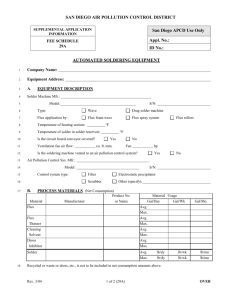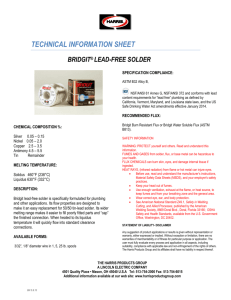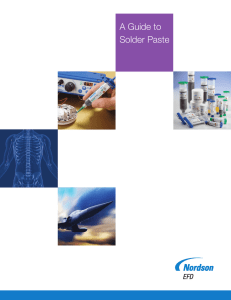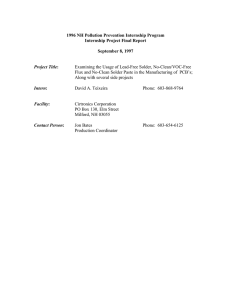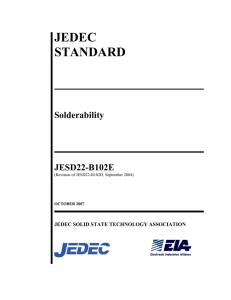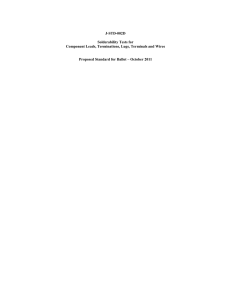3.37 (Class 13) Review
advertisement
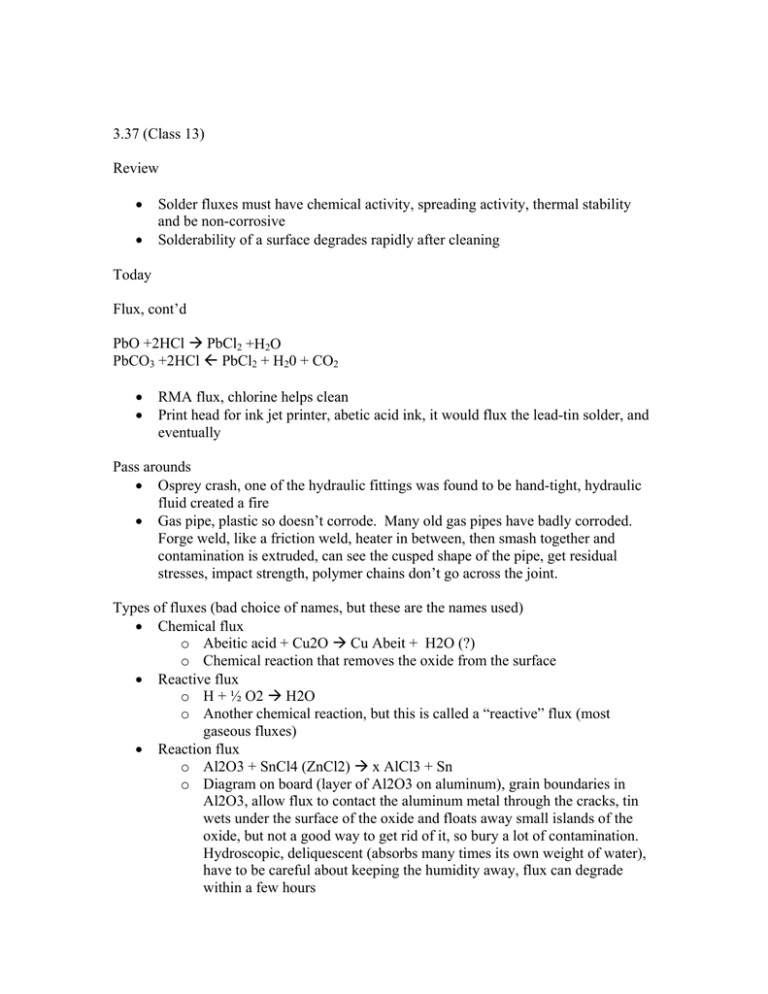
3.37 (Class 13) Review • • Solder fluxes must have chemical activity, spreading activity, thermal stability and be non-corrosive Solderability of a surface degrades rapidly after cleaning Today Flux, cont’d PbO +2HCl Æ PbCl2 +H2O PbCO3 +2HCl Å PbCl2 + H20 + CO2 • • RMA flux, chlorine helps clean Print head for ink jet printer, abetic acid ink, it would flux the lead-tin solder, and eventually Pass arounds • Osprey crash, one of the hydraulic fittings was found to be hand-tight, hydraulic fluid created a fire • Gas pipe, plastic so doesn’t corrode. Many old gas pipes have badly corroded. Forge weld, like a friction weld, heater in between, then smash together and contamination is extruded, can see the cusped shape of the pipe, get residual stresses, impact strength, polymer chains don’t go across the joint. Types of fluxes (bad choice of names, but these are the names used) • Chemical flux o Abeitic acid + Cu2O Æ Cu Abeit + H2O (?) o Chemical reaction that removes the oxide from the surface • Reactive flux o H + ½ O2 Æ H2O o Another chemical reaction, but this is called a “reactive” flux (most gaseous fluxes) • Reaction flux o Al2O3 + SnCl4 (ZnCl2) Æ x AlCl3 + Sn o Diagram on board (layer of Al2O3 on aluminum), grain boundaries in Al2O3, allow flux to contact the aluminum metal through the cracks, tin wets under the surface of the oxide and floats away small islands of the oxide, but not a good way to get rid of it, so bury a lot of contamination. Hydroscopic, deliquescent (absorbs many times its own weight of water), have to be careful about keeping the humidity away, flux can degrade within a few hours How long for various surfaces, treated with different coating • Steam aging, protect with resin lacquer, true of many others • Some coatings work better than others • Solder right after cleaning, or coat it with something if want storage life • DEC, TAB bonding, 2 month delay to make outer lead bonds, just thin gold plate, contamination still gets through • VAX, management wanted to show that they were shipping product, would ship Coke machines out the last two weeks of every quarter, same size and weight as the computer, accounts would count these as they went out Science of solderability Tests • Automated Dip Test o Machine, put copper wire in vat of flux and metal, examine if solder attaches • Rotary Dip Test o Checks wave soldering action • Globule test • Surface Tension Balance o Same a automated dip test, measure the force going in and out o Resulting curve (on overhead, also in packet) o Get all kinds of data, parameters o Machine is approx $50k Compositions of solders (see handouts) • Must be controlled very carefully o < 50ppm Al, Mg, Zn because they form intermetallics o Sb, added in small amounts 0.3%, to prevent “tin pest” (40% lead already prevents this) o As, Fe <200-500ppm, form intermetallics o Bi <.25% can help wetting, many people looking at this as a way to get the lead out of solder, problem is recyclability, if get the bismuth (say in auto components) then makes the steel in autos nonrecylable o Cd form dross (oxide that forms on the liquid surface of the metal), segregates in solder bath o Au, Cu forms intermetallics o Ni rarely found, no detrimental effects o Ag o S 7ppm max, severely retards wetting When are gravity forces and when are surface forces dominant? • Soldering book, picture of thru-holes on a printed surface board • Want a nice conical fillet • Bond number = gravitational force / surface tension force • For a liquid, gravitational force = rho*g*h (dimensionless) • Surface tension = gamma/r (cylinder) • • • • • • • • • Want to know if shape of fillet will change with gravity, say if want to solder vertically, or upside down, etc. Equation developed on board Bond # = 1 when forces are equivalent, radius is approx 3mm, 1/8” If solder joint is less than 1/8” then orientation doesn’t matter If solder drops are larger, then gravity will have an effect Ball bearing company, ruthenium powder, wanted to make the balls for ball point pens out of ruthenium, refillable pens, inks can be corrosive, typically make balls out of wires, but ruthenium only available as powder, electron beam machine, spread ruthenium powder into small indentations, then used gas-tungsten arc, made 10,000 balls Similar problem from Draper lab, 10mil iridium balls, needed 1million of them, cost $1each, wanted to get the price down, needed 3000degC furnace, made on, process drove the company to reduce their price, using freeflight fall to create balls Watertown arsenal, wanted to make cannonballs this by freeflight, doesn’t work, but does work for small balls, say under 1mm Braze diamond to a stainless steel substrate
